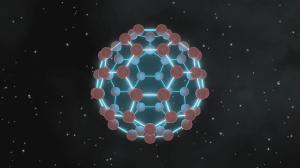Blog
Spaceballs
17 July 2015
 NASA/JPL-Caltech
NASA/JPL-CaltechThere are buckyballs in space. More formally known as fullerenes, these carbon molecules such as C60 have long been known to exist in space due to the complex chemistry that can occur between gas and dust in interstellar clouds. But we now know fullerenes can help explain one of the nagging mysteries of astronomy known as diffuse interstellar bands.
Diffuse interstellar bands are absorption features seen in stellar spectra. While many absorption lines can be identified with particular atoms or molecules, DIBs don’t have a clear identification. But two bands in the infrared (at 958 and 963 nanometers) were thought to be caused by C60. Now a paper in Nature confirms this hypothesis.1 In this work, the team looked at the spectra of buckyballs when cooled to about 6 Kelvin (a common temperature for interstellar clouds). They observed absorption bands 963.27 ± 0.1 and 957.75 ± 0.1 nanometers, in good agreement with the interstellar bands.
So that’s two DIBs identified, and a few hundred more with origins yet to be discovered.
Campbell, Ewen K., et al. “Laboratory confirmation of C60+ as the carrier of two diffuse interstellar bands.” Nature 523.7560 (2015): 322-323. ↩︎